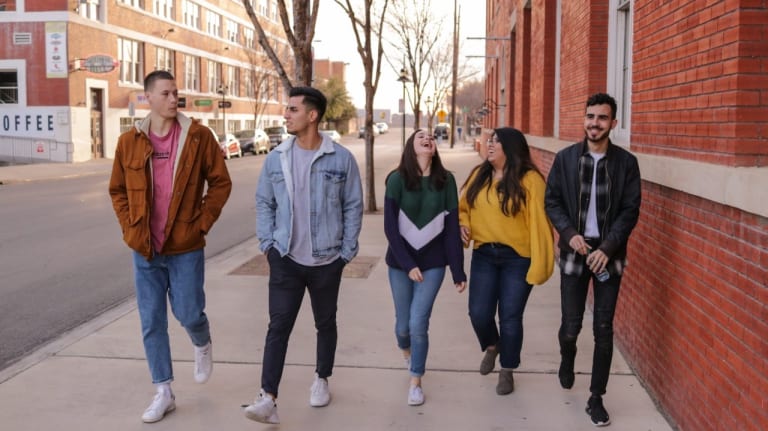Originally posted on hopelab.org See original article>
It was a crisis before, and it’s an emergency now.
Prior to COVID-19, loneliness among young people was already a crisis of epidemic proportions.
A recent report from health insurer, Cigna, found that nearly 4 in 5 Gen Z Americans (79%) experience at least one of the key clinical indicators of loneliness, making these young people the loneliest generation alive today. We know that social relationships are as important as other lifestyle factors-think nutrition, physical activity, sleep, smoking-in determining how happy and healthy we are, and how long we live. Loneliness during the college years is particularly dangerous; students who lack social connections are more likely to get poor grades and to drop out of school before graduation. Now more than ever, as we physically isolate, college students need support to develop the skills that will help them have satisfying relationships, ultimately supporting their health and wellbeing, and that of society as a whole. It was a crisis before, and it’s an emergency now.
It was a crisis before, and it’s an emergency now.
As a clinical psychologist and researcher in digital health, I am constantly thinking about how to use technology to support mental health in our most at-risk populations. At Hopelab, my colleagues and I partner directly with young people to co-create behavioral change technology to address some of the toughest challenges facing their health and wellbeing. Nod is an app that has been in development for over a year, originally designed to help college students form connections and combat loneliness. In recent weeks, responding to the urgency of need, we adapted Nod for use during COVID-19, offering a tool to help students feel less lonely during a time when they are physically isolated from their campuses, classmates, jobs, and communities. The good news is that our increasingly digital world, plus our extra time at home, offer the chance for students to connect in ways they may not have done before.
Nod is informed by evidence-based research, launched in partnership with Grit Digital Health, and co-created by and for young adults.
How can Nod help college students come out of this time more connected? By helping them remember five important components behind forming lasting connection:
1. Making new social connections takes work, especially now
We’re often told that college is the time when we’ll make the best friends of our lives. We’ll show up, and there they’ll be, ready to connect and go make some memories. In reality, for most of us, meeting new people takes work, and can feel uncomfortable. This becomes doubly true in a virtual world. Without the benefit of in-person classes or bumping into acquaintances around campus, building connections in isolation requires seeking out channels to meet new people, then making a plan to get to know them better. It can feel like a grind, but that doesn’t mean you’re doing it wrong. It just takes some practice.
2. Start with something easy
“How could I ever make new friends right now?” If you feel this way, you’re not alone. The good news is that there are so many small ways to connect digitally, and a few of them are likely to feel possible even if connecting with people makes your palms sweat. For example, while you may not feel comfortable jumping into a virtual meeting with a group from a class, consider starting by asking one classmate for their phone number to text about an upcoming assignment. Or, if class assignments are not a way you want to connect, use this time to check out a club or group with interests similar to yours (such as learning Spanish, cooking, art, or cycling). Start with finding that group, then DM someone to ask for a link to the next online meeting.
3. Give yourself permission to take a few risks
Making lasting connections means going beyond small talk. It means getting to the deeper aspects of our lives, our values, our hopes, our dreams. This can be even more daunting in a virtual environment. But if you challenge yourself to share something vulnerable in a text message with a friend today, it will help you to connect with that person in a more meaningful way than if you had just said hello. Here are a few things you can try:
- When someone asks how you are doing today, don’t feel pressured to say “fine” if you’re not. Dare to be vulnerable-you may benefit by asking for a friend’s perspective on your situation, and your friend may also come out of the interaction glad that you felt comfortable being honest with them.
- Do something that pushes you outside of your comfort zone to deepen a connection you already have with someone. For example, if you’re feeling anxious in an interaction, tell the other person that you are feeling that way. Then maybe you can take a deep breath together (or even three!). Poof! You’ve bonded.
- Not sure what to say? Try asking someone one of 36 questions that have been shown to get past the small talk and increase closeness.
4. Cut yourself some slack
Making new social connections is a two-way street. Sometimes you have the best intentions and it still might not go your way. Maybe you reach out to someone and they don’t respond. Or maybe you have an interaction that leaves you feeling like it wasn’t that successful. This can be tough, especially if you’re already feeling lonely or depressed. Negative moods can influence our thinking so that we are even harder on ourselves than a situation warrants. The good news is that there are tools to combat this. If you come out of an interaction feeling stressed or anxious, here are some strategies that can help reduce your bad feelings:
- Try to find something positive about what happened. Ask yourself, “What’s a kinder, more positive way I can interpret what just happened?”
- Practice self-compassion. We are often harder on ourselves than we would be on others. Ask yourself, “What would I tell a friend if they had experienced the same thing?”
- Remind yourself that you can’t know what others are thinking or feeling, even if you think you can.
- Use your breath. Grab your favorite meditation app (most are free right now) and take a breather, literally. Things are always a little bit better after a few purposeful, deep breaths.
5. Celebrate your wins
When things go well, it can be easy to ignore it and just move on. But slowing down and taking the time to celebrate ourselves during this time will support our mental health in the long run. When you’ve had a good interaction, here are some ways to support the good feels:
- Give yourself some credit. It can be easy to downplay our accomplishments. Especially social ones. When things go well, take a pause and say a mantra that works for you (“I rocked that,” or, “Wow, that went well”).
- Be thankful. When things feel good, take a moment to soak it in by thinking of something you are grateful for. It could be anything at all. Research shows that expressing gratitude improves our mood in the moment.
- Send out some kindness. Expressing kindness toward others is another way to soak up good feelings. The next time a social interaction goes well, take a moment to send some kindness out into the universe. Wish someone well. Text someone and say you are thinking about them.
Nod is available for free on the Apple and Google Play stores.
The habits students build today can set in motion patterns that will help us all have a less lonely future.
Let’s take this opportunity to make lasting social connections so that our post-COVID world is a more connected, meaningful place.
For more on Dr. Ramo’s work follow her on Twitter and check out her website.
Originally published at https://thriveglobal.com.




